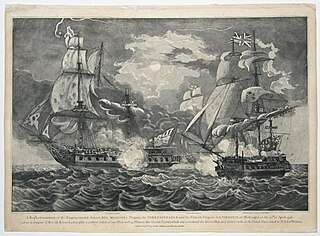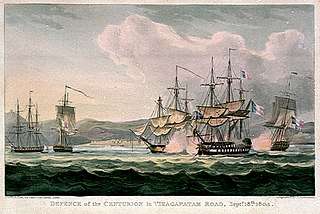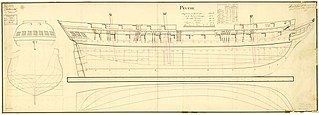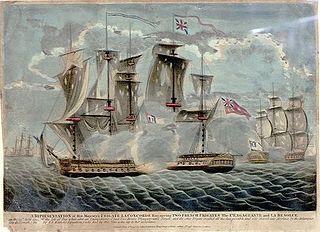
Jacques Bergeret (Bayonne, 15 May 1771 - Paris, 26 August 1857) was a French naval officer and admiral.

Jacques Bergeret (Bayonne, 15 May 1771 - Paris, 26 August 1857) was a French naval officer and admiral.
Bergeret was born in Bayonne on 15 May 1771, and joined the merchant navy at the age of 12, when he sailed to Pondicherry aboard the merchantman Bayonnaise. Two years later, he volunteered for the French Royal Navy on the corvette Auguste, bound for an exploration campaign in the Red Sea.
In 1786, Bergeret returned to the merchant navy, and quickly rose to the rank of second lieutenant. Prior to 1792, he sailed mostly to Mauritius.
At the French Revolution, Bergeret joined the Navy as an ensign, in April 1793. He served in convoy escorts aboard the frigate Andromaque and later aboard the corvette Unité, notably fighting HMS Alceste.
Promoted to lieutenant, Bergeret was put in command of the frigate Virginie, and served in Villaret-Joyeuse's squadron in Brest. He distinguished himself in the Battle of Groix, and was promoted to Captain in March 1796.
On 22 April, Virginie encountered the division of Sir Edward Pellew, comprising the 44-gun razée HMS Indefatigable and the frigates HMS Argo, HMS Concord, HMS Révolutionnaire, HMS Amazon and their prize Unité, captured on 13 April. [1]
Virginie retreated and the British squadron gave chase, joining with the French frigate around 23:00. Indefatigable closed in and exchanged broadsides, without succeeding in her attempts at raking Virginie. The gunnery exchange lasted for 4 hours, until the British frigates caught up. Bergeret then struck his colours in the face of an overwhelming opponent. [1]
Bergeret was brought to England, and invited to stay at Pellew's mansion, near Plymouth. Bergeret and Pellew stayed in touch their entire life afterwards. After two years, Bergeret returned to Paris on parole to negotiate an exchange with Sidney Smith. The Directoire never consented, and Bergeret returned to London. When Smith escaped in 1798, the British government regarded the exchange as completed and released Bergeret. [1]
Back in France, Bergeret was put in command of the 74-gun Dix-août, taking part in Bruix' expedition of 1799, and later of the 80-gun Foudroyant.
At the Peace of Amiens, Bergeret resigned his commission and sailed to Mauritius, where he armed a merchantman, the Psyché.
In 1804, Bergeret was reinstated and Psyché was bought by Decaen and commissioned in the Navy as a frigate. Bergeret raided commerce on Psyché until 14 February, when a naval battle opposing Psyché, Équivoque and Thetis to HMS San Fiorenzo ended with Psyché's capture. Bergeret was Pellew's prisoner for the second time. Exchanged after a brief captivity, Bergeret was put in command of the Créole and ordered back to France with reports and despatches.
In February 1809, Bergeret was put in command of the Rochefort station, raising his pennant on the 80-gun Ville de Varsovie. He was supposed to have received reinforcements from Willaumez' squadron, but Willaumez ended up entangled in the Battle of Les Sables-d'Olonne, without support from Bergeret. Bergeret and Willaumez fought over the responsibility for the fiasco, and Napoleon removed them both, replacing them with vice-admiral Zacharie Allemand. Bergeret remained out of favour until the end of the Empire.
At the Bourbon Restoration, Bergeret was put in command of a division to ferry Russian prisoners of war back home. During the Hundred Days, Decrès did not attempt to recruit him, which eased his subsequent career under the monarchy. In 1817, Bergeret led an expedition to retake possession of French Guyane, with his pennant on Hector. He later had command of the 80-gun Neptune, the Duc de Berry, and the Foudroyant.
Promoted to contre-amiral in 1819, he commanded the Caribbean station and took part in the Admiralty Council. He rose to Vice-Admiral in 1831, under the Monarchy of July, and received appointment as préfet maritime of Brest. From 1835, he served as vice-president of the Admiralty Council, and he became a Pair de France in 1841.
He retired from the Navy in 1848, and became a Senator at the beginning of the Second Empire. By then, he was the last living captain of the French Revolution.
Bergeret died in 1857 and was buried in Brest.

HMS Indefatigable was one of the Ardent-class 64-gun third-rate ships-of-the-line designed by Sir Thomas Slade in 1761 for the Royal Navy. She was built as a ship-of-the-line, but most of her active service took place after her conversion to a 44-gun razee frigate. She had a long career under several distinguished commanders, serving throughout the French Revolutionary Wars and the Napoleonic Wars. She took some 27 prizes, alone or in company, and the Admiralty authorised the issue of four clasps to the Naval General Service Medal in 1847 to any surviving members of her crews from the respective actions. She was broken up in 1816.

Charles-Alexandre Léon Durand, Comte de Linois was a French admiral who served in the French Navy during the reign of Napoleon Bonaparte. He commanded the combined Franco-Spanish fleet during the Algeciras Campaign in 1801, winning the First Battle of Algeciras before losing the Second Battle of Algeciras. He then led an unsuccessful campaign against British trade in the Indian Ocean and South China Sea in 1803, being defeated by a harmless fleet of the East India Company during the Battle of Pulo Aura and ending his cruise and sea-going career being bested in battle by John Warren in the action of 13 March 1806. Following the Bourbon restoration, Linois was appointed Governor of Guadeloupe. He supported Napoleon during the Hundred Days and so, on his return to France, he was forced to resign and was court martialled. Although acquitted, he was placed in retirement and never served again.

The Battle of the Basque Roads, also known as the Battle of Aix Roads, was a major naval battle of the Napoleonic Wars, fought in the narrow Basque Roads at the mouth of the Charente River on the Biscay coast of France. The battle, which lasted from 11–24 April 1809, was unusual in that it pitted a hastily-assembled squadron of small and unorthodox British Royal Navy warships against the main strength of the French Atlantic Fleet. The circumstances were dictated by the cramped, shallow coastal waters in which the battle was fought. The battle is also notorious for its controversial political aftermath in both Britain and France.

Droits de l'Homme was a Téméraire class 74-gun ship of the line of the French Navy during the French Revolutionary Wars. Launched in 1794, the ship saw service in the Atlantic against the British Royal Navy.
Jean-Baptiste Raymond de Lacrosse was a French sailor, admiral and hero of the French Revolutionary Wars.

HMS Amazon, was a 36-gun frigate, built at Rotherhithe by Wells & Co. in 1795 to a design by Sir William Rule. Carrying a main battery of 18-pounder long guns, she was the first of a class of four frigates. She spent her entire career in the Channel, part of the Inshore Squadron under Sir Edward Pellew. She was wrecked in Audierne Bay in 1797, following an engagement with the French ship-of-the-line, Droits de l'Homme.

Count Honoré Joseph Antoine Ganteaume was a French Navy officer and Vice-admiral.

Jean-Baptiste Philibert Willaumez was a French naval officer and nobleman who served during the French Revolutionary Wars and Napoleonic Wars. Willaumez joined the French Navy at the age of 14, and proved to be a competent sailor. Having risen to the rank of pilot, he started studying navigation, attracting the attention of his superiors up to Louis XVI himself. Willaumez eventually became an officer and served under Antoine Bruni d'Entrecasteaux in his expedition to rescue Jean-François de Galaup, comte de Lapérouse and explore the Indian Ocean and Oceania.
Joseph-Marie Nielly was a French naval officer and admiral.

Virginie was a 40-gun frigate of the French Navy, lead ship of its class.

The Sémillante was a 32-gun frigate of the French Navy and the lead ship of her class. She was involved in a number of multi-vessel actions against the Royal Navy, particularly in the Indian Ocean. She captured a number of East Indiamen before she became so damaged that the French disarmed her and turned her into a merchant vessel. The British captured her and broke her up in 1809.

The action of 13 January 1797 was a minor naval battle fought between a French ship of the line and two British frigates off the coast of Brittany during the French Revolutionary Wars. During the action the frigates outmanoeuvred the much larger French vessel and drove it onto shore in heavy seas, resulting in the deaths of between 400 and 1,000 of the 1,300 persons aboard. One of the British frigates was also lost in the engagement with six sailors drowned after running onto a sandbank while failing to escape a lee shore.

Psyché was a 36-gun vessel built between February 1798 and 1799 at Basse-Indre (Nantes) as a privateer. As a privateer she had an inconclusive but bloody encounter with HMS Wilhelmina of the Royal Navy, commanded by Commander Henry Lambert, off the Indian coast in April 1804. The French then brought her into service in June 1804 as the frigate Psyché. In February 1805 she encountered HMS St Fiorenzo, under the command of the same Henry Lambert, now an acting captain. After a sanguinary engagement of over three hours, Psyché surrendered. The British took her into service as HMS Psyche. In British service she captured several prizes and took part in the capture of Mauritius and in an operation in Java. She was broken up at Ferrol in 1812.

The Battle of Les Sables-d'Olonne was a minor naval battle fought on 23 February 1809 off the town of Les Sables-d'Olonne on the Biscay Coast of France between a French Navy squadron of three frigates and a larger British squadron of ships of the line. The French squadron had sailed from the port of Lorient on 23 February in an effort to link up with a fleet from Brest under Jean-Baptiste Willaumez, but missed the rendezvous and was pursued by a British blockade squadron under Rear-Admiral Robert Stopford. The French commander, Commodore Pierre Roch Jurien, anchored his squadron under the batteries which protected the town of Les Sables-d'Olonne in the hope of dissuading an attack.
Éléonore-Jean-Nicolas Soleil was a French Navy officer and captain.
His Majesty's Hired armed lugger Duke of York served the Royal Navy from 14 October 1794 to 2 January 1799 when she foundered in the North Sea. She was of 5744⁄94 tons (bm) and was armed with eight 4-pounder guns.

Concorde was a 32-gun frigate of the French Navy, lead ship of her class. Built in Rochefort in 1777, she entered service with the French early in the American War of Independence and was soon in action, capturing HMS Minerva in the West Indies. She survived almost until near the end of the war when HMS Magnificent captured her in 1783. Not immediately brought into service due to the draw-down in the navy after the end of the war, Concorde underwent repairs and returned to active service with the outbreak of war with France in 1793 as the fifth-rate HMS Concorde.

HMS Alert was launched in 1793 for the Royal Navy. In May 1794 the French Navy captured her and took her into service as Alerte. A few months later the Royal Navy destroyed her.
Pierre-Édouard Plucket was a French Navy officer and privateer.
Betzy was the Channel Islands brig Betsey that the French frigate Sémillante captured in May 1793, that the French Navy took into service, and that the Royal Navy recaptured in 1796.